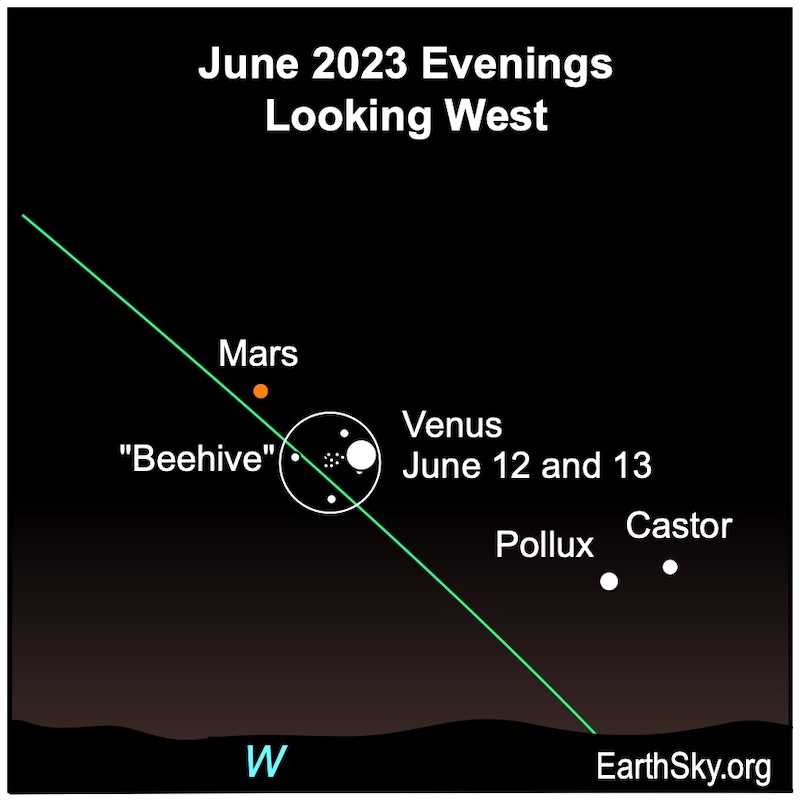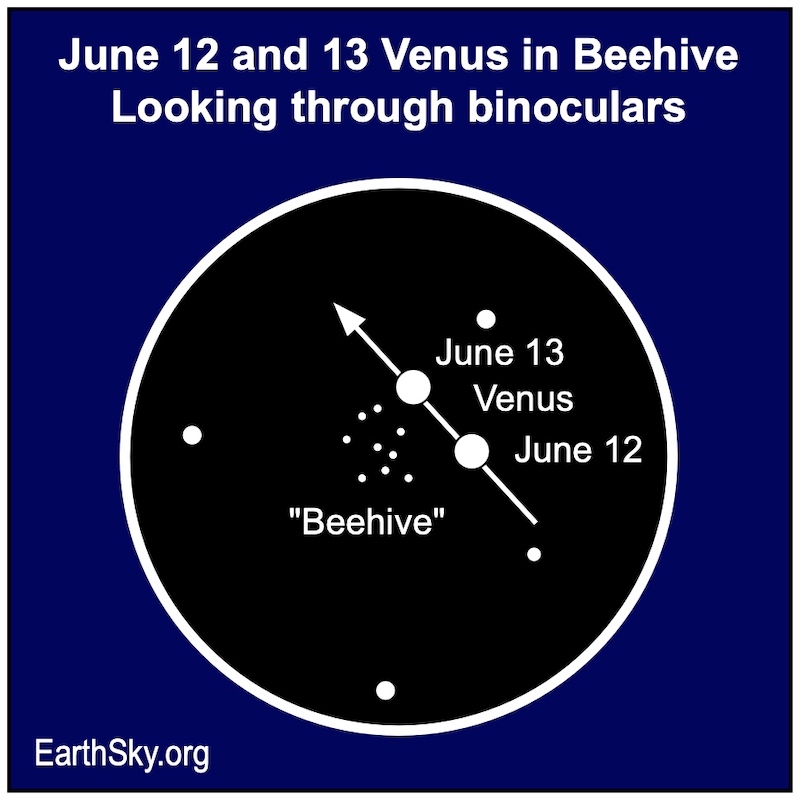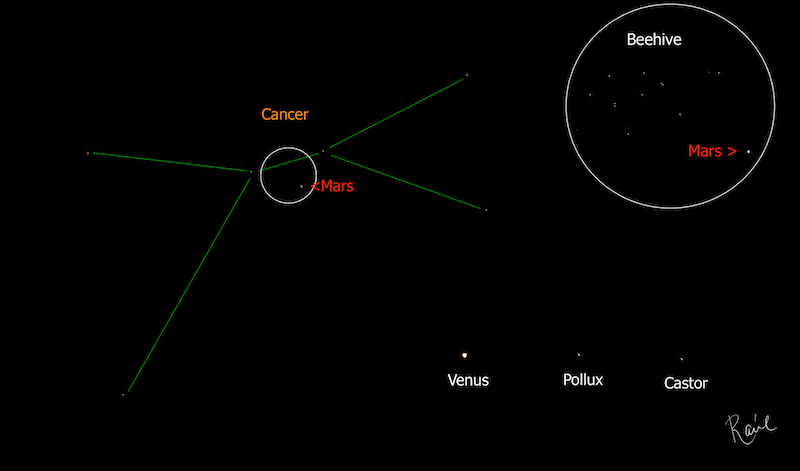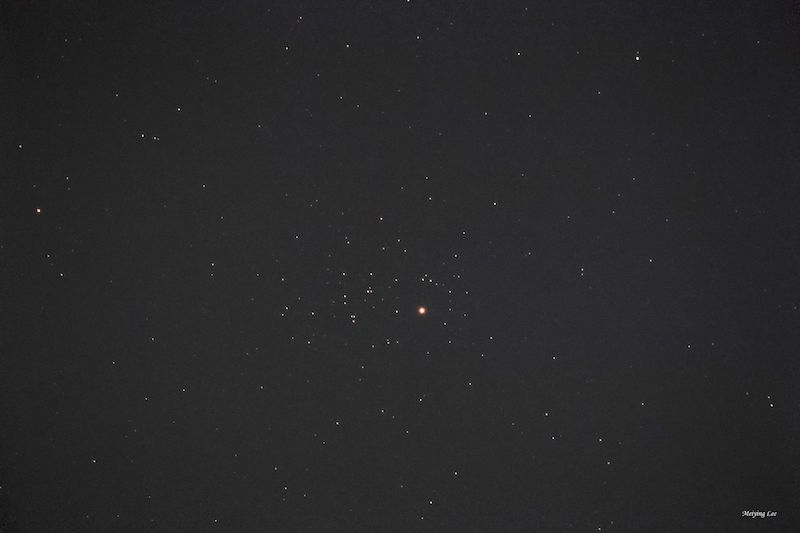Venus and the Beehive
On the evenings of June 12 and 13, 2023, you can spot Venus – the brightest planet – as it passes by a famous star cluster known as the Beehive. Nearby Venus will appear as a big, bright diamond passing by dozens of tiny distant diamonds in this star cluster. On both evenings, Venus is about one degree – or two full moons side-by-side – from the Beehive.
First, look for brilliant Venus in the west after sunset. At magnitude -4.2, Venus easily dominates the early evening sky. You might also notice two bright stars lower in the sky than Venus. They’re the bright stars in Gemini the Twins, Pollux and Castor.
Above Venus and the twin stars is a bright, reddish light … and that’s Mars.
Then, if you’re in a dark-sky site or have binoculars, you can spot a smudge of light on the sky’s dome in the vicinity of Venus. That smattering of stars is the Beehive star cluster, in the constellation Cancer the Crab.
In late May and early June – around June 1 and 2, 2023 – Mars was a delightfully bright light among the dim Beehive cluster. And now it’s brilliant Venus’s turn. Venus will be a beacon among the dim stars in the cluster.
Unless your sky is very dark, you’ll need binoculars to pick out the cluster’s stars. The Beehive will be easier to spot if you place Venus out of your field of view.
Telescopes will reveal more of the 1,000 members of the Beehive cluster.

A closer look at the Beehive star cluster
It’s with optical aid that the true nature of this star cluster comes alive.
The stars in this cluster lie about 577 light-years distant. That’s in contrast to Venus, which is just light-minutes away.
And – when you gaze at the Beehive – think about how many planets might reside among these 1,000 stars. We already know of at least two (Pr0201b and Pr0211b).
Do you have a photo to share? Submit it at EarthSky Community Photos. We surely enjoy seeing them.

Community photos of Mars buzzing the Beehive
Earlier this month, Mars buzzed right in front of the Beehive star cluster. Here are some of the photos submitted to our EarthSky Community Photos.


More photos of Mars buzzing the Beehive


Bottom line: Spot Venus and the Beehive star cluster together on June 12 and 13, 2023. You’ll want binoculars to get a good view of the starry cluster making a sparkling accent to dazzling Venus.
Want to see more night sky events? Visit EarthSky’s night sky guide
Our charts are mostly set for the northern half of Earth. To see a precise view from your location, try Stellarium Online.
The post Venus and the Beehive! Together June 12 and 13 first appeared on EarthSky.
from EarthSky https://ift.tt/nqQMsva
Venus and the Beehive
On the evenings of June 12 and 13, 2023, you can spot Venus – the brightest planet – as it passes by a famous star cluster known as the Beehive. Nearby Venus will appear as a big, bright diamond passing by dozens of tiny distant diamonds in this star cluster. On both evenings, Venus is about one degree – or two full moons side-by-side – from the Beehive.
First, look for brilliant Venus in the west after sunset. At magnitude -4.2, Venus easily dominates the early evening sky. You might also notice two bright stars lower in the sky than Venus. They’re the bright stars in Gemini the Twins, Pollux and Castor.
Above Venus and the twin stars is a bright, reddish light … and that’s Mars.
Then, if you’re in a dark-sky site or have binoculars, you can spot a smudge of light on the sky’s dome in the vicinity of Venus. That smattering of stars is the Beehive star cluster, in the constellation Cancer the Crab.
In late May and early June – around June 1 and 2, 2023 – Mars was a delightfully bright light among the dim Beehive cluster. And now it’s brilliant Venus’s turn. Venus will be a beacon among the dim stars in the cluster.
Unless your sky is very dark, you’ll need binoculars to pick out the cluster’s stars. The Beehive will be easier to spot if you place Venus out of your field of view.
Telescopes will reveal more of the 1,000 members of the Beehive cluster.

A closer look at the Beehive star cluster
It’s with optical aid that the true nature of this star cluster comes alive.
The stars in this cluster lie about 577 light-years distant. That’s in contrast to Venus, which is just light-minutes away.
And – when you gaze at the Beehive – think about how many planets might reside among these 1,000 stars. We already know of at least two (Pr0201b and Pr0211b).
Do you have a photo to share? Submit it at EarthSky Community Photos. We surely enjoy seeing them.

Community photos of Mars buzzing the Beehive
Earlier this month, Mars buzzed right in front of the Beehive star cluster. Here are some of the photos submitted to our EarthSky Community Photos.


More photos of Mars buzzing the Beehive


Bottom line: Spot Venus and the Beehive star cluster together on June 12 and 13, 2023. You’ll want binoculars to get a good view of the starry cluster making a sparkling accent to dazzling Venus.
Want to see more night sky events? Visit EarthSky’s night sky guide
Our charts are mostly set for the northern half of Earth. To see a precise view from your location, try Stellarium Online.
The post Venus and the Beehive! Together June 12 and 13 first appeared on EarthSky.
from EarthSky https://ift.tt/nqQMsva

Aucun commentaire:
Enregistrer un commentaire